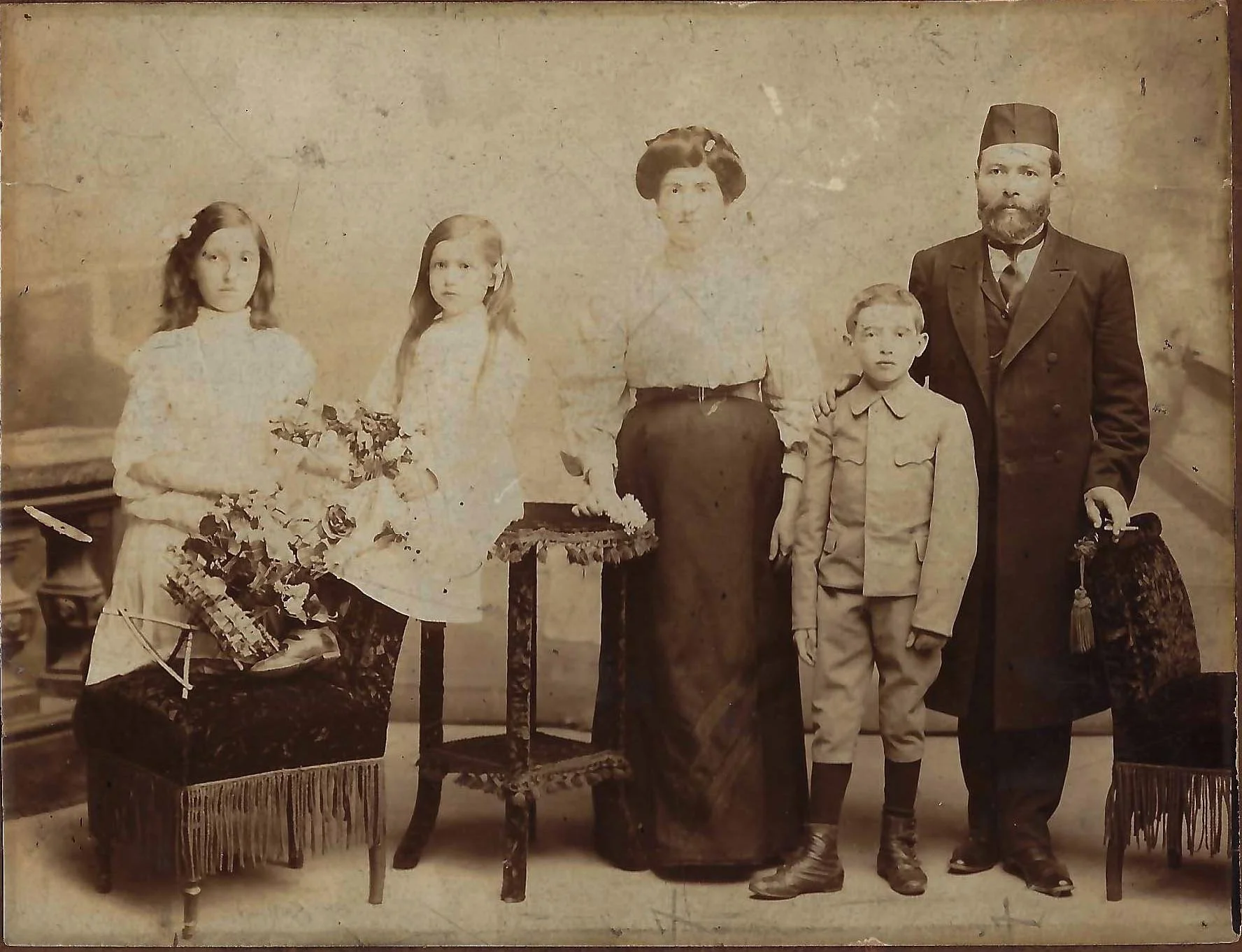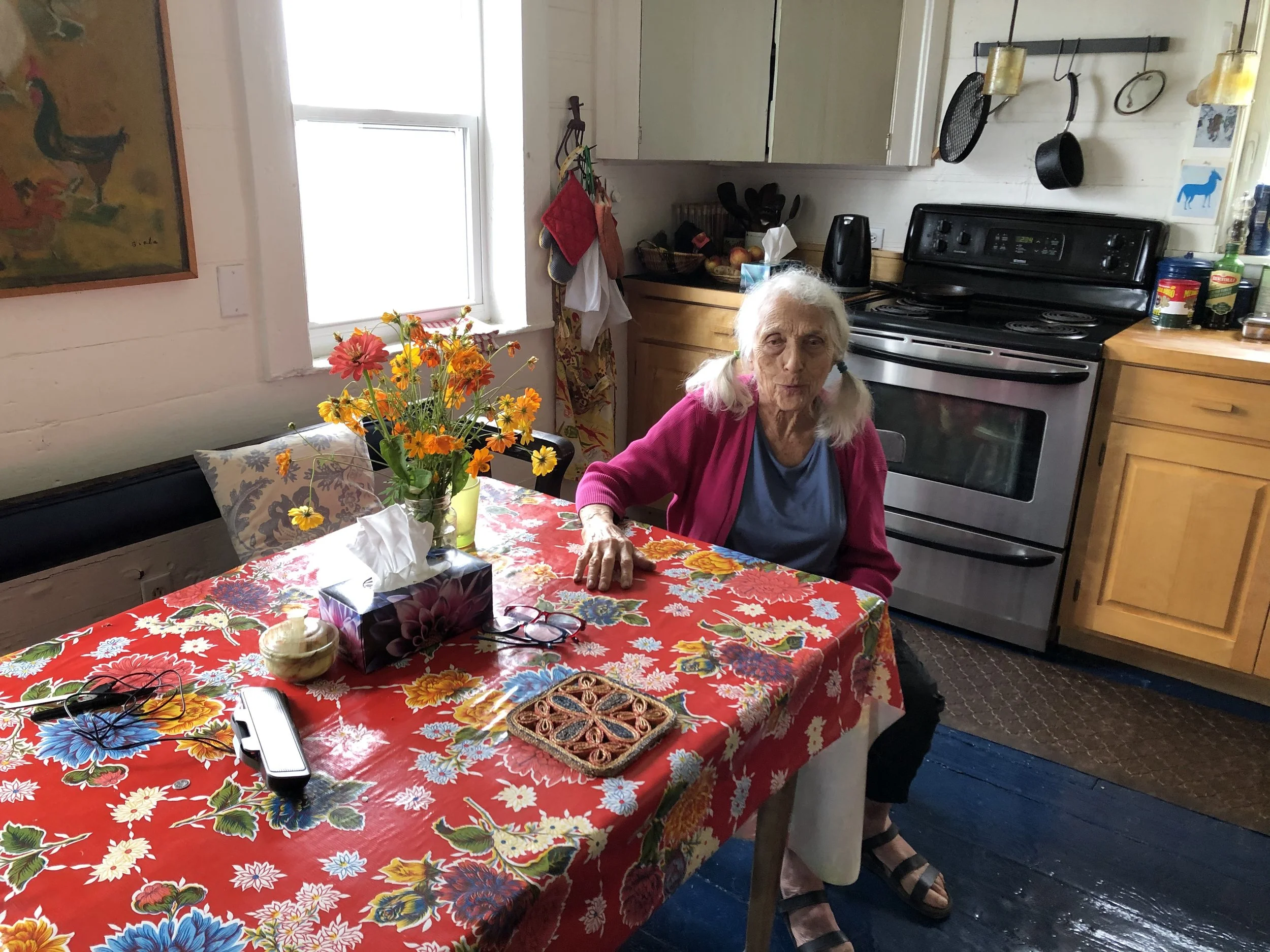The following images are meant to illustrate aspects of my memoir, Lotus Girl. Where possible, passages from the book appear in italics following the descriptive caption. While these images will display on mobile devices, they will look better on a laptop or desktop monitor.
My father as a boy with his parents, his siter Biala seated, and a cousin c. 1910
All four of my grandparents were part of the great migration of Eastern European Jews to America in the early part of the twentieth century.
My father and my aunt Biala c. 1925
Photographs suggest a sassy young lady who knew something of fashion, smartly dressed in clothes made by her father.
My aunt Biala and her husband, Daniel Brustlein
… a painter from Alsace who was also known as Alain, the name he used for the cartoons that he had drawn for The New Yorker.
At the Bronx Zoo c. 1949
When I was about six years old, my parents took Hermine and me on a special summer excursion to the Bronx Zoo. Giving us a penny apiece to throw into a wishing well evoked my own first experience of spontaneous all-inclusive compassion.
On the floor of my father’s studio on 10th Street c. 1950
Despite [my father’s] domineering role, he was the more playful of the parents, amusing us with hand puppets, teaching us to play checkers, and setting us up with pastels and sketch pads.
Visiting friends in New Jersey c. 1955
On visits to country places, I jumped at the chance to ride even though I did not know how, and only luck rescued me from stupidity.
My mother c. 1958
I remember a coquettish smile, but she was embarrassed by her rotten teeth, made more discolored by chain-smoking unfiltered cigarettes, and she smiled with her lips closed.
My father in his studio, 1973 (Photograph by Arnold Newman)
My father was preoccupied with making art. Even that configured into his ideals of goodness, and he most definitely wanted to be a good person.
The house in Provincetown that my parents bought in 1958
Inside and out, the house had the elegant simplicity of Shaker aesthetics. No curlicues. The rough edges were confined to familial relations.
In Kyoto, 1965. On left, with my landlady
Whatever I wore, I was always too imprecise, too casual, too American. I was trim and not tall, but in Kyoto I felt like an unwieldy affront to Japanese delicacy.
Riding in the Annapurna range, Nepal, 1966
I was on a grey mare and as usual set off without a plan, elated to be cantering through fields in sight of the mountains.
At the dining table in the apartment on 23rd street c. 1967 (Photograph by Henri Cartier-Bresson)
The unconditional love that my father and I had long held in the privacy of our hearts… remained trapped, defended by arrogance, mistrust and self-doubt. We were both so stubborn and proud.
With my sister, Hermine c. 1967
Hermine and I had finally outgrown the competitive contention of our earlier years, and I saw her frequently.
Traveling overland from Europe to India, 1970
The ancient bus, round at both ends, had the same shape as the boa constrictor in The Little Prince after it swallowed the elephant.
In the Caucasus Mountains, enroute to India, 1970
The bus broke down often and died one day in the frigid Caucasus Mountains, forcing its twenty passengers to spend the night in a concrete box of a room in a gas station, sleeping on the stone-cold floor. A leaden dawn revealed a black bear chained to a stake in front of the building, gnawing on a frozen camel.
With Pat Steir, Fall 1976, after I returned from Montreal
I moved in with Pat Steir, a painter who had a loft on Mulberry Street, near Canal, when the neighborhood still showcased its Italian heritage.
With my dog Inook c. 1978
Inook often took off for hours at a time while I became her lady-in-waiting. If others were kept waiting on my account, I might put on a show of exasperation, but privately I adored her inconvenient wildness.
Left: Philip Glass and Richard Serra building my cabin in Nova Scotia, 1977. Zachary Glass in foreground; right: Port Ban, Cape Breton Island
The cabin measured twelve by sixteen feet, with views of the seaway, no indoor plumbing, running water, or electricity, but perfect nonetheless. To take a shower, I walked down to the cove below and stood under the cold waterfall.
Rudy Wurlitzer in Poona, India c. 1977
Following the peripatetic style of many American seekers, he had left Arica and traveled to India to spend time in the Pune ashram of Bhagwan Rajneesh.
Assistant to Richard Serra for a site-specific project in Washington, D.C. c. 1978
I obtained permits for the lifts from the city government with the stipulation that we only work from six to eight o’clock on Sunday mornings, under the protective custody of the police, who closed the streets to traffic.
Lex Hixon in his garden in Riverdale, NYC c. 1985
Lex knew a lot about interacting with spiritual exemplars of every faith through his radio show In the Spirit. This hugely important broadcast in New York City (1971-1983) introduced new players of prominence in the emergent spread of Buddhism, Vedanta, and Sufism through ground-breaking interviews.
Getting ready to visit the White House with Richard Serra, 1979
Two years after the PADC debacle, Richard was invited to the White House to attend a gathering of artists and art administrators…Richard invited me to join him, joking of our triumphant return to the capital.
Standing, left to right: Michael Herr with baby, Claudia Herr, Valerie Herr, John Giorno, Ernie McCormack, Rudy Wurlitzer, Thinley Norbu Rinpoche, Vivian Kurz, David Lewis, Pema Yeshe (Michael Abrams), Roger Weil
Seated, left to right: Me, Kesang (Rinpoche’s eldest daughter), Mark Muhich, Jamyang (Rinpoche’s wife), a few unknown people, Terry Clifford, Lin Lerner, a few more unknown people, Bob Kragen, Toni Erlich, Sybil Weil, Mary Bowen.
June 1978. John Giorno arranged for Thinley Norbu Rinpoche to lead a residential retreat at a dude ranch in the Wind River Valley in Wyoming.
With Vivian Kurz in 1978 at the retreat in the Wind River Valley led by Thinley Norbu Rinpoche
Vivian and I shared a cabin and for one month cohabited cloud-cuckoo-land where mythic Tibet met the American West.
With Dharma teachers and friends. Top row, left to right: Tulku Thundup Rinpoche, Dodrupchen Rinpoche IV, Thinley Norbu Rinpoche, Lisa Anderson, John Giorno, and me. Bottom row: unknown, Vivian Kurz, Terry Clifford, Lin Lerner.
Looking back at the fledgling Tibetan center, I see an odd assortment of Westerners new to Buddhism who wanted to change ourselves and change the world. We had the uninformed zeal of converts, too naïve and too enamored of our new religion to intuit the thorny thickets lying in wait…..I don’t believe that any among us at the time knew how bruising this path could be—or yet understood how much getting messed up was a critical part of it.
My house at Sight Point, Cape Breton Island, in 1952, long before I bought it (Photograph by Timothy Asch)
In 1983 I returned to Cape Breton and impulsively bought a house…I had not been looking for one and can still remember the offer coming out of my mouth, strained and squeaky, as if I had just swallowed a ventriloquist. But this wasn’t just any house: it was both exceptionally dilapidated and exceptionally beloved…
Moses on the beach at Port Ban c. 1990
A guy I knew from the other side of town called one day. A part-shepherd pup had been hanging around the bulrushes by the pond near his cabin. They’d just stop by for a visit. No obligations. This is how I met Moses, the love of my life.
Moses with Pema Chodron at Sight Point
Throughout the 1990s Pema spent more time at my house than I did, often arriving from Gampo Abbey with an attendant for long stretches, and taking care of Moses while I stayed glued to my desk at the Tricycle office in New York.
Glassman Sensi and Maezumi Roshi outside the Greyston mansion c. 1982
The setting was grand—and for a Zen center, somewhat grandiose.
With Maezumi Roshi at the grave of Nyogen Senzaki (1876-1958)
With the Dalai Lama, April 1991 (photograph by Tano Maida)
When I presented the Dalai Lama with a tiny gold tricycle and explained the various associations, he added, playing with the movable handlebars, And relative and absolute!
The first issue of Tricycle: The Buddhist Review, 1991
For the first cover, Frank Olinsky chose an improbable image of His Holiness the Dalai Lama... a three-quarter angle shot of the Dalai Lama, his head tilted back slightly and his face turned away from the camera. The image captured a timeless, layered serenity. He looks both more vulnerable than usual and more enigmatic.
Lawrence Shainberg in New York City, 2022. We first met in 1976 and five years later, he introduced me to Bernie Glassman.
Larry Shainberg recently spoke to me of the humor in growing old. I asked him: What about growing old do you find so funny?
The humiliation, he said.
Running an early Tricycle meeting with Moses in the foreground
With Allen Ginsberg at Change Your Mind Day in Central Park, 1994
At the next Tricycle board meeting, held at Philip Glass’s townhouse on the Lower East Side, I proposed a day of meditation in Central Park—free and outdoors, just like in the time of the Buddha…the event become Change Your Mind Day.
With Elizabeth Murray on hiking trip to Utah c. 1995
I loved Elizabeth, her bony, alley-cat toughness and obstinacy, her proclamations made in a soft voice with one hand on a twisted hip and her chin raised in defiance.
James Shaheen in the Tricycle office c. 2000
James interrupted his workday in the editorial division of Forbes magazine to come for an interview. He wore a suit and tie…. His full face had an abundant sweetness, and his dress and polite demeanor suggested he had anticipated a real interview at a real office.
Freyja, Icelandic mare, born in 1993
Now my hair is white like Freyja’s who, this summer, lies down more frequently and her hind legs tremble when she first stands.
June Leaf sitting in my kitchen, 2022
….she told me wistfully, I feel old for the first time in my life. I did not tell her that she had told me the exact same thing last year.
Mingyur Rinpoche in 2015, on first returning from his wandering retreat. Turning Confusion into Clarity had been published during his absence
During the retreat (in 2009) Mingyur Rinpoche asked for my help in putting together a chapbook on the foundational practices for his non-Tibetan students. This modest request became a 350-page book.
2003 at the Yarne Retreat at Gampo Abbey with Pema Chodron
Among women, aversion to being bald was the most dominant obstacle to temporary ordination. It’s such a visceral affront to vanity—matched only by the pride that arises with doing it.
Joa, Icelandic mare, who came to live me 22 years ago, when she was 12 years old
Joa, with her fawn-colored coat divided by a chocolate stripe down the center of her back and her thick, long mane of various shades of blond, ash, and brown, for which the neighbors nicknamed her Tina Turner.
With Mambo, a rescue dog from downtown Manhattan. Moses was a hard act to follow, but my life with dogs would continue—as it always has c. 2000















































